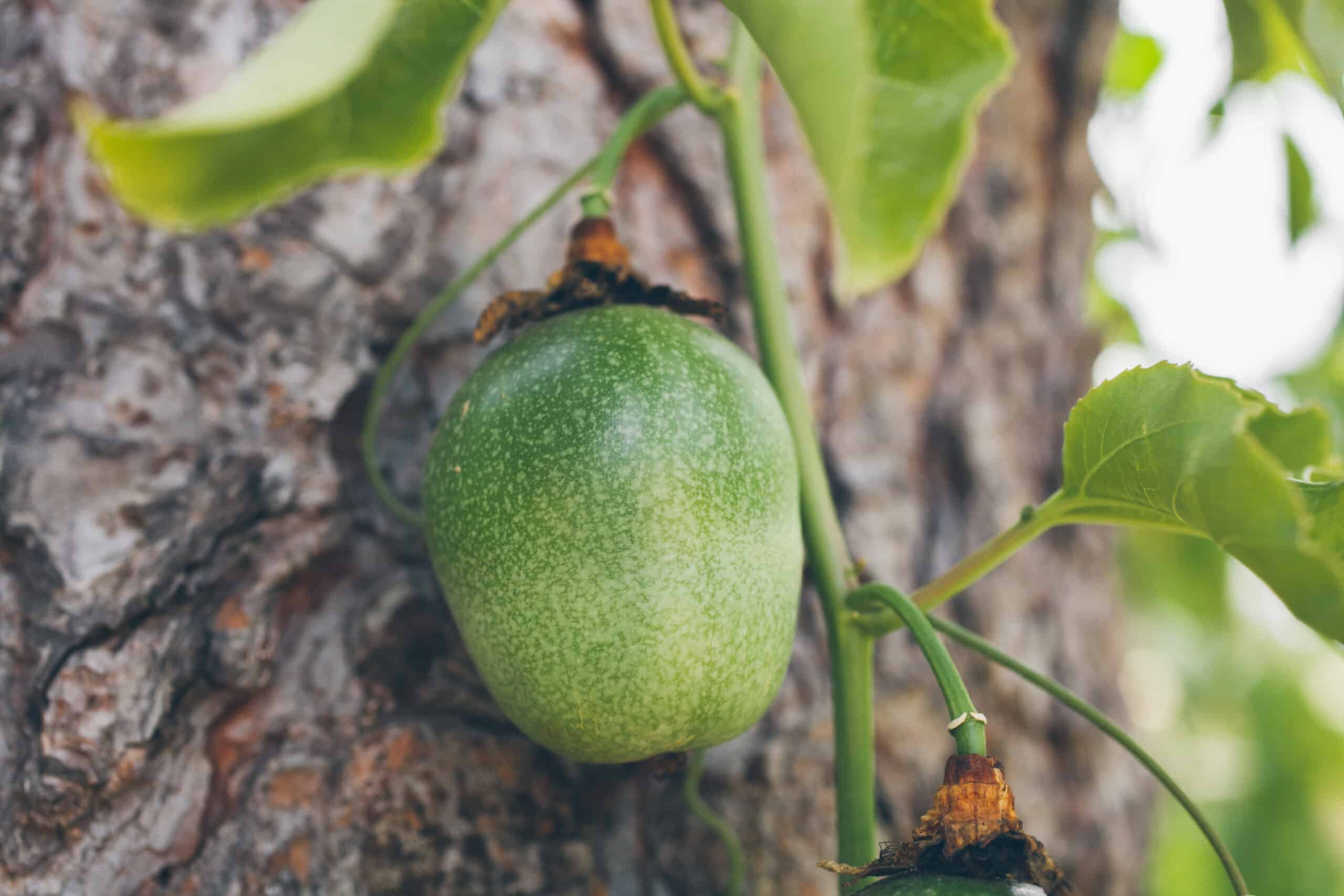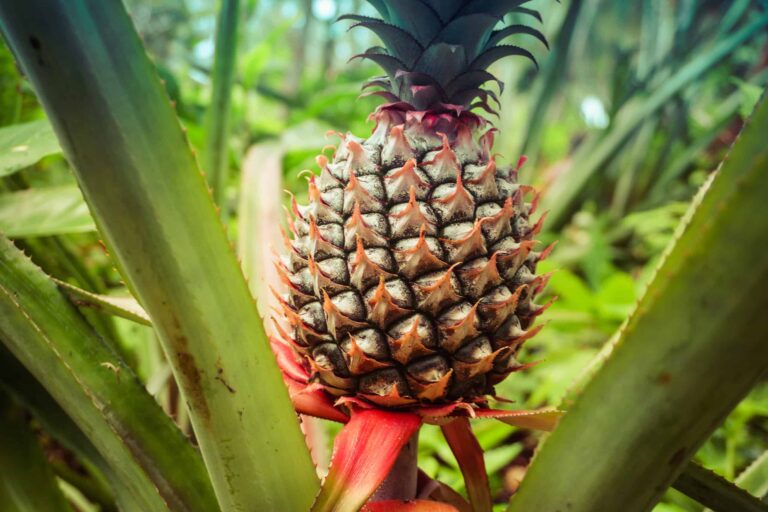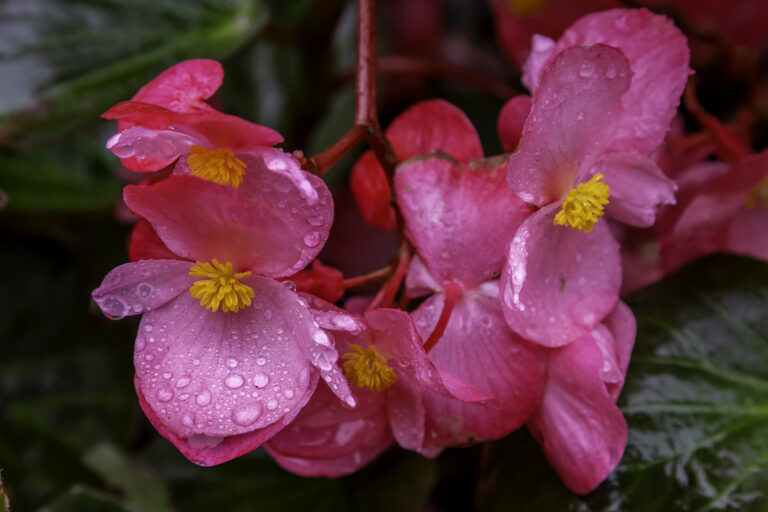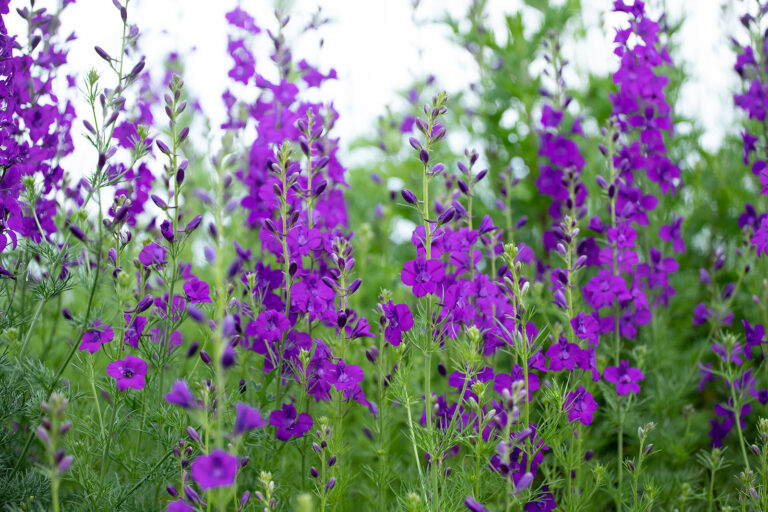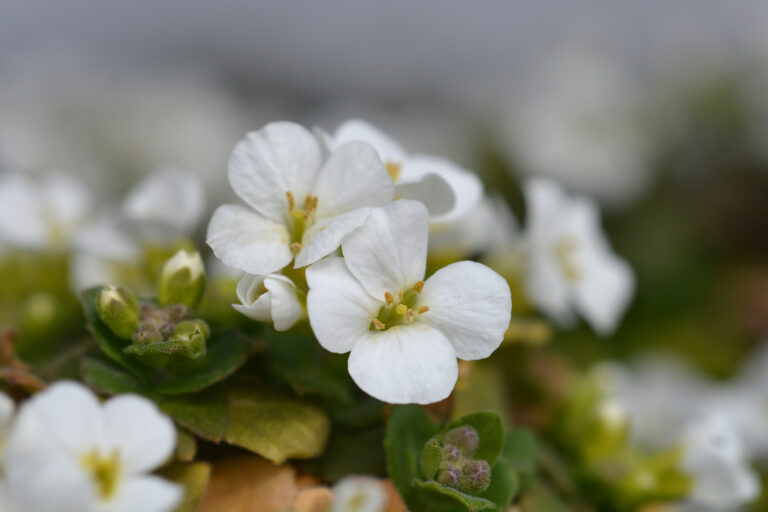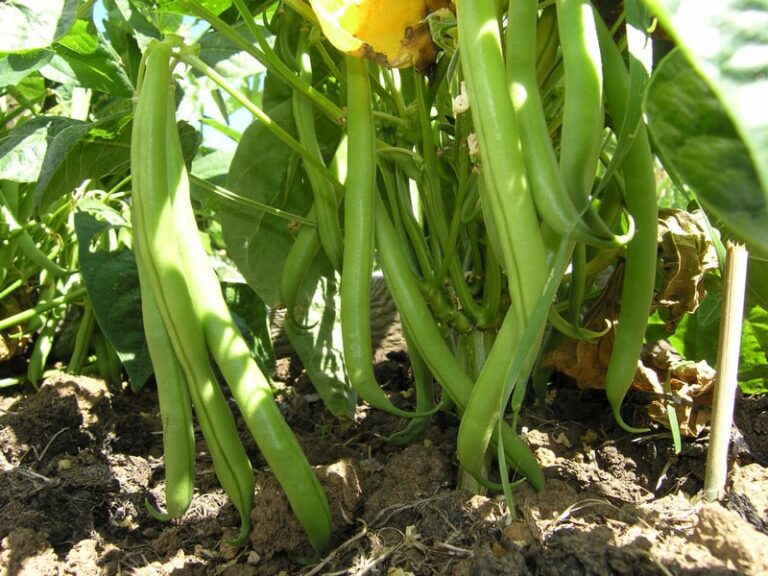How to Plant, Grow, and Harvest Passion Fruit
Passion fruit is a form of berry that grows on the passion fruit plant, also called the passionfruit vine. Passion fruit is easy to grow.
Passion fruit belongs to a large family of vining plants, some are ornamental, and many produce edible fruits. The passion flower is among the most beautiful and striking flowers. The delicious fruit is commonly eaten raw or juiced.
There are two common types of passion fruit plants–purple and yellow. The purple passion fruit plant (Passiflora edulis) is the most common. That fruit is slightly smaller than a lemon. There are several hybrids of the purple passion fruit. The yellow passion fruit plant is the second most widely grown after the purple passion fruit. It is bright yellow and its fruit is about the size of a grapefruit. Purple passion fruit is sweet than yellow passion fruit which is also more acidic.
Related article:
Both the purple variety and yellow variety passion fruits are spherical to ovoid in shape. Both fruits have an outer shell that is hard and slippery. The interior of both fruits is a transparent pulp with hard black seeds. The pulp is the edible part of the fruits; it is soft, sweet-tasting, and aromatic.
The many cultivars of the purple common passion fruit and the related species share many characteristics of the purple passion fruit and are planted, grown, pruned, and harvested in the same way.
Good Products At Amazon For Passion Fruit Success:
Here is your complete guide to growing passion fruit!
About passion fruit
- The botanical name of purple passion fruit is Passiflora edulis; the botanical name of yellow or golden passion fruit is Passiflora edulis flavicarpa.
- Passion fruit is native to Brazil and tropical America. Spanish missionaries gave the plant its common name because of its intricate and striking beautiful flowers which they said represented the Passion of Christ.
- Passion fruit is a perennial, evergreen vining plant in tropical regions. It can grow to 30 or 40 feet high and nearly as wide. It is widely grown in tropical and semitropical regions of the world. In the United States, the plants are grown mostly in Florida, Hawaii, and California. Passion fruit can be grown indoors in more temperate climates of North America.
- Passion fruit plants have showy flowers 2 to 3 inches (5-8 cm) across with five greenish-white sepals surround by five white petals and a fringelike corona of white-tipped rays emerging from a rich purple base. The leaves are glossy green with three lobes and serrated edges. Small tendrils allow passion fruit to climb vigorously.
- Purple passion fruit is oval, egg-shaped, and 2 to 5 inches in diameter; ripe passion fruit has purple to reddish-purple skin when ripe. The rind is inedible. The yellow-orange pulp surrounds small black seeds. The seeds are edible but are usually removed before eating.
- Passion fruit is ready for harvest about 80 days after flowering.
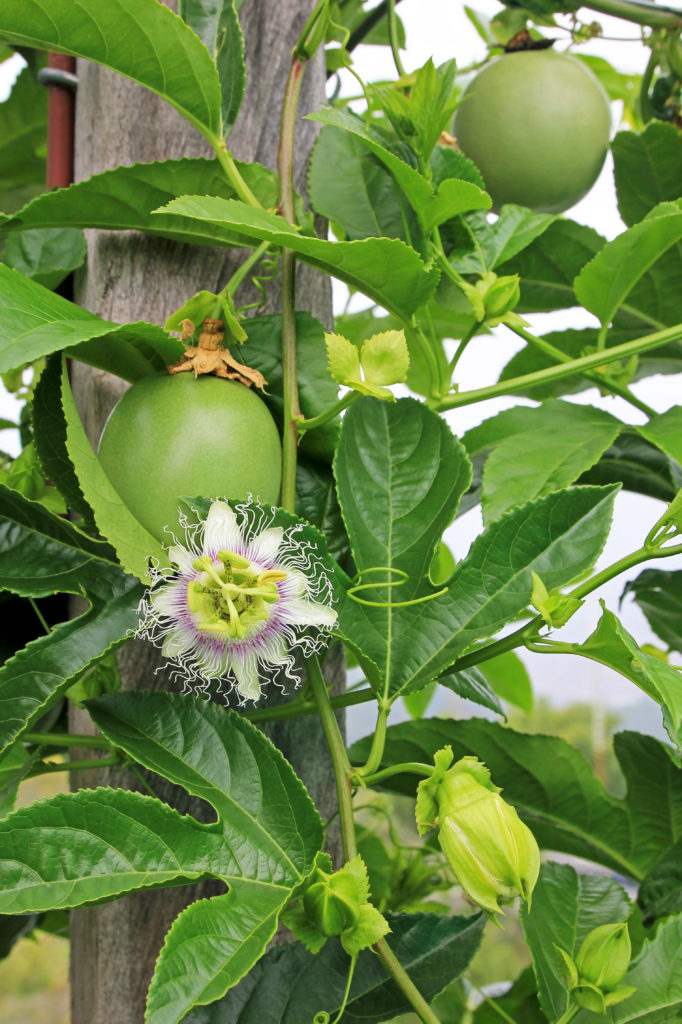
Best climate and site to grow passion fruit
- Passion fruit is a tropical and subtropical plant. It is native to South America. Passion fruit vine grows best in frost-free regions.
- There are a few cultivars that can survive temperatures in the upper 20sF. Vines may lose some of their leaves in cool winters; the roots will resprout even if the foliage is killed.
- Plant passion fruit in full sun except in areas where summers are very hot; in very hot regions plant passion fruit in partial shade.
- Passion fruit is a vining plant that grows rapidly; plant passion fruit where it can climb a trellis or chain-link fence. Passion fruits have tendrils and are natural climbers.
- Passion fruit grows best in well-drained, compost-rich, sandy loam with a soil pH of 5.5 to 6.5.
- Passion fruit does not grow well where there is a high salt content in the soil.
- Avoid planting passion fruit where the soil is constantly wet. Also, avoid planting passion fruit in spots where it can be damaged by wind.
- Avoid planting passion fruit in low spots where cold air or frost can settle.
- If you grow passion fruit indoors, place it in a bright south-facing window.
Choosing the right passion fruit plant
- Yellow passion fruit is sweet, acidic, and tropical with mild floral notes.
- Purple passion fruit has a flavor and aroma richer than yellow passion fruit. It is also less acidic.
- The flavor of both is reminiscent of guava.
Passion fruit quick-growing tips
- Passion fruit needs frost-free winters and an average temperature of 68 to 75°F (20-24°C) during the growing season.
- Passion fruit grows well in the corner of a sunny patio or against a south-facing wall, if not grown indoors.
- Start passion fruit seeds indoors and set young plants outdoors in late spring at the same time you plant out melons.
- Grow passion fruit in well-drained soil rich in organic matter.
- Water passion fruit vines plentifully and feed them with a tomato fertilizer (high in nitrogen).
- Train passion fruit vines up wires or a trellis. A mature vine can grow 15 to 30 feet tall and 10 to 25 feet wide. An entire plant can cover a very large trellis or fence.
- In winter cut back last year’s sideshoots to within two buds of the main stems; they won’t fruit again; cutting back sideshoots encourages the new growth of new sideshoots in early spring that will bear fruit in about 60 to 80 days.
Passionfruit Seeds Available at Amazon:
How to plant passion fruit
- Passion fruit can be grown from seed, but is most often grown from cuttings started indoors or in a greenhouse.
- Fresh seeds from recently harvested plants can be sown in the spring after harvest. Start the seed indoors in a sterile seed starting mix. Soak the seed in warm water overnight before sowing. Fresh seeds germinate months ahead of older seeds.
- Grow young plants at 70°F under grow lights until seedlings are 6 to 8 inches tall.
- Cuttings and grafted plants can also be started indoors. See the section on propagation.
- Plant passion fruit where it cannot be damaged by frost or cold winter temperatures.
- Plant passion fruit in well-drained soil. A soil pH of 5.5 to 6.5 is optimal.
- In regions with clay soils, grow passion fruit vines in a container or raised bed.
- Set out passion fruit seedlings when they are 6 to 8 inches (20 cm) tall.
- Prepare a planting hole half again as deep as the root ball and twice as wide.
- Add a mixture of 2 cups of kelpmeal and 1 cup of bone meal to the hole prior to planting.
- Set the plant in the hole and refill the hole around the root ball with a combination of native soil and aged compost or commercial organic planting mix. Firm in the soil so that no air pockets.
- Form a small basin of soil around the plant to hold irrigation water.
- Space young plants 10 to 12 feet apart; vines will quickly fill the space in between.
- Mulch around the base of the plant to conserve soil moisture, especially in dry, hot regions. Mulch will also stem root damage.
Spacing passion fruit
- Passion fruits are vigorous growers. One vining plant can grow 30 to 40 feet. Train vines up a trellis or support to avoid stems of separate plants tangling. Training vines on a trellis will make fruit harvest easier.
Container growing passion fruit
- Passion fruit can be grown in containers, but the vigorous vines will need the support of a trellis.
- Choose a container 24 inches wide and deep or larger.
- Passion fruit grown in a container can be moved to a greenhouse for the winter as long as the vining plant can be supported.
Watering passion fruit
- Keep the soil evenly moist for quick, even growth. Keep the soil moist but not wet. Plant in moisture-retentive, well-drained soil.
- Consistent soil moisture is important for best fruit production; if the soil dries, the fruit will shrivel and drop.
- Overwatering can cause root rot.
- Passion fruit vines grown indoors should be placed in a saucer with pebbles; fill the saucer with water to keep the air humid.
Feeding passion fruit
- Passion fruit plants are heavy feeders; use a 5-5-10 fertilizer. Use a high-potassium fertilizer to encourage fruiting. Too much nitrogen will result in leafy growth and less fruit set.
- Too much nitrogen can result in vigorous foliage growth at the expense of flowers and fruits.
- Yellowing leaves can be caused by a lack of magnesium or nitrogen.
Training and pruning passion fruit
- Train passion fruit to a trellis or overhead support such as a T-post to keep separate vines from tangling and to make the harvest of fruit easier. Passion fruit has tendrils and is a natural climber.
- Prune to eliminate dead and dying and weak and unproductive growth. Prune to keep the plants within bounds. Thin passion vine to encourage air circulation.
- Fruiting occurs in the leaf joints of the current season’s growth, so regular pruning will encourage fruit growth from the main branches.
- Cut back vigorous growth
- Prune after harvest; cut back vigorous growth by one-third.
- In cool winter regions, prune in spring, not after harvest.
- Prune to keep passion fruit within bounds and to make the harvest of fruit easy.
- Avoid removing foliage that shields fruit from hot summer sunburn.
- If left unpruned, passion fruit vines can grow out of control and produce fruit out of reach.
Passion fruit pollination
- Purple passion fruit plants (Passiflora edulis) are self-pollinating–meaning a flower can be pollinated with its own pollen. Some passiflora species require cross-pollination (see list below).
- Yellow passion fruit plants (Passiflora edulis f. Flavacarpa) are not self-pollinating. They depend on insects to transfer pollen from one plant to the next for pollination.
- Even self-pollinating passion fruit varieties rely on bees for pollination; that is because passion fruit pollen is sticky. Wind pollination does not commonly occur. The carpenter bee is the most effective passion fruit pollinator. Because the pollen is heavy and sticky pollination by honeybees is difficult; larger carpenter bees do the work.
- Pollination most often occurs when temperatures and warm and the air is humid.
- Pollination to fruiting can take about 6 months in tropical regions and up to a year in cooler climates.
Passion fruit pests
- Passion fruit is susceptible to attack by insect pests and diseases.
- Snails can strip passion fruit vine of leaves and bark leaving the plant susceptible to disease.
- Snails and slugs can eat small plants. Sprinkle diatomaceous earth around plants and handpick and destroy these pests or trap and drown them in tins of beer set near plants.
- Snails will feed on foliage; use beer traps and overturned citrus rinds to attract and catch snails. Drown snails in soapy water.
- Caterpillars chew on passion fruit leaves, stems, and fruit. Control caterpillars with Bacillus thurigiensis (Bt).
- The Gulf fritillary butterfly–also called passion butterfly–is the adult of an orange and black caterpillar that will eat passion fruit leaves. Handpick the caterpillars and destroy them.
- Passion fruit is susceptible to attack by nematodes. Release beneficial nematodes into the soil.
Passion fruit diseases
- Fusarium wilt fungal disease can attack passion fruit. Avoid wetting leaves. Spray plants with a fungicide.
- Fusarium fungal disease can cause foliage to wilt and die back; remove infected foliage; space plants well apart to encourage air circulation. Plant disease-resistant varieties, mostly flavicarpa varieties.
- Woodiness virus causes discoloration and crinkling of leaves, fruit is small and deformed. Aphids commonly spread this disease.
- Crown rot and collar rot can occur if passion fruit is in soil that is waterlogged. Make sure the soil is well drained, especially clay soil or plant in a raised bed or container.
- Anthracnose is a fungal disease that can attack passion fruit. Make sure the soil is well drained and train or prune plants for maximum air circulation.
- Root-knot nematodes can attack roots; there is no cure for infected plants; solarize the soil when possible.
Overwintring passion fruit
- Passion fruit can survive temperate (cooler) winters if the roots are protected by a thick mulch–a minimum of 2 inches of mulch.
- Passion fruit grown in containers can be moved into a greenhouse in winter.
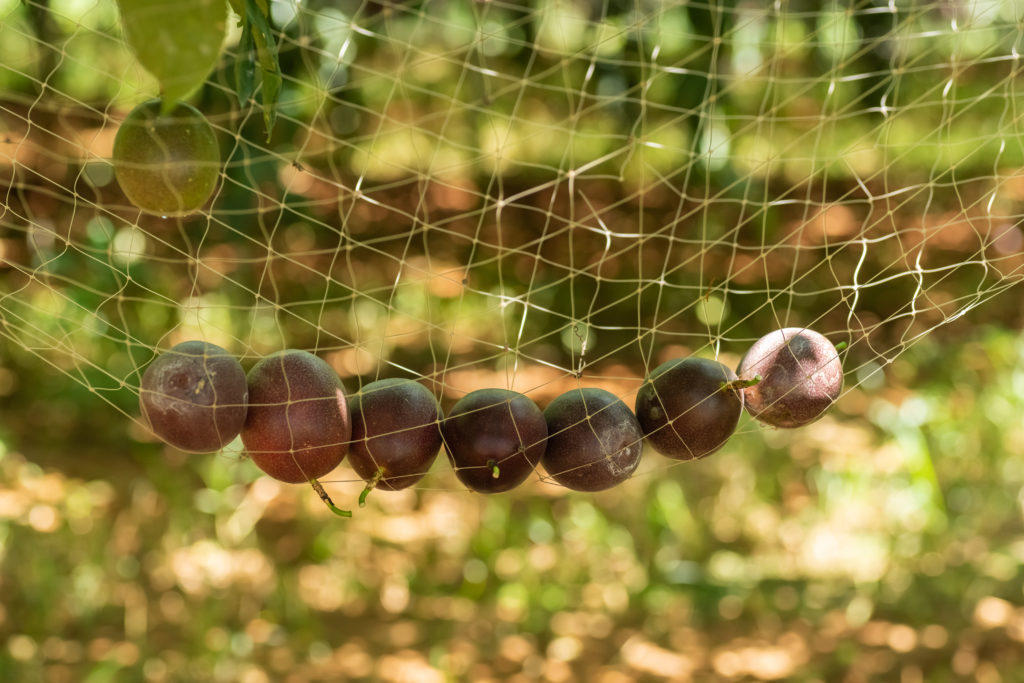
How to harvest passion fruit
- The fruit berries are ready for harvest 70 to 80 days after pollination, usually in mid to late summer and sometimes longer. Mature fruits can take up to 6 months. Plant in spring for mature fruit to harvest in fall.
- The fruit will turn from deep green to deep purple or yellow when ripe. The fruit is sweetest when slightly shriveled.
- Ripe fruit comes away from the stem easily when handled. Ripe fruit will also fall to the ground if not picked.
- Pick passion fruit when they reach full color or gather dropped fruits daily.
- Yellow passion fruit has a thick skin and can sit on the ground for several days. Red passion fruit is thin-skinned and should be harvested before it hits the ground or very shortly after. Purple passion fruit falls in between.
How to store passion fruit
- Passion fruit will keep for 2 to 3 weeks in the refrigerator.
- Wash and gently dry passion fruit and place in a polyethylene bag.
- Slightly shriveled fruit can still be eaten.
- Both passion fruit and juice can be frozen.
How to prepare and serve passion fruit
- The flavor of passion fruit can be compared to guava.
- Ripe passion fruit is best eaten shortly after picking. Fruit that is not fully ripe can be made into preserves or juice.
- Passion fruit can be halved and the interior flesh is eaten raw scooped out with a spoon; sprinkle with sugar or added to fruit salads. The rind of passion fruit is not edible. The seeds are edible.
- Fresh passion fruit pulp can be used as a dessert topping on cakes or ice cream.
- Passion fruit pulp can be made into a marinade or sauce.
- Passion fruit can be juiced or made into ice pops.
- Use passion fruit juice in ice cream, butter, sorbet, and mousse, or drink it alone or mixed with other fruit juices.
- Make passion fruit into jam or jelly.
Passion fruit propagation
- Passion fruit is usually grown from seed. Seed removed from the fruit can be planted right away. Germination will occur in 10 to 20 days. Sow seed ½ to 1 inch deep. Seeds should not be exposed to light during germination.
- Seed from plants with wrinkled fruit that has just been picked is best; wrinkled or crinkled skin appears on the ripest fruits. Rub the seed with a nail file and then soak it overnight in warm water before planting; this will speed germination.
- Passion fruit can be propagated by layering or by stem cuttings and also by grafting. Yellow passion fruit rootstock is used for grafting.
- To propagate passion fruit by semi-hardwood stem cuttings, choose a healthy stem and cut it about 6 inches down with 3 to 4 leaf nodes; remove the bottom leaves then dip the cutting in a rooting hormone and plant it in potting mix. Rooting should occur in about 90 days.
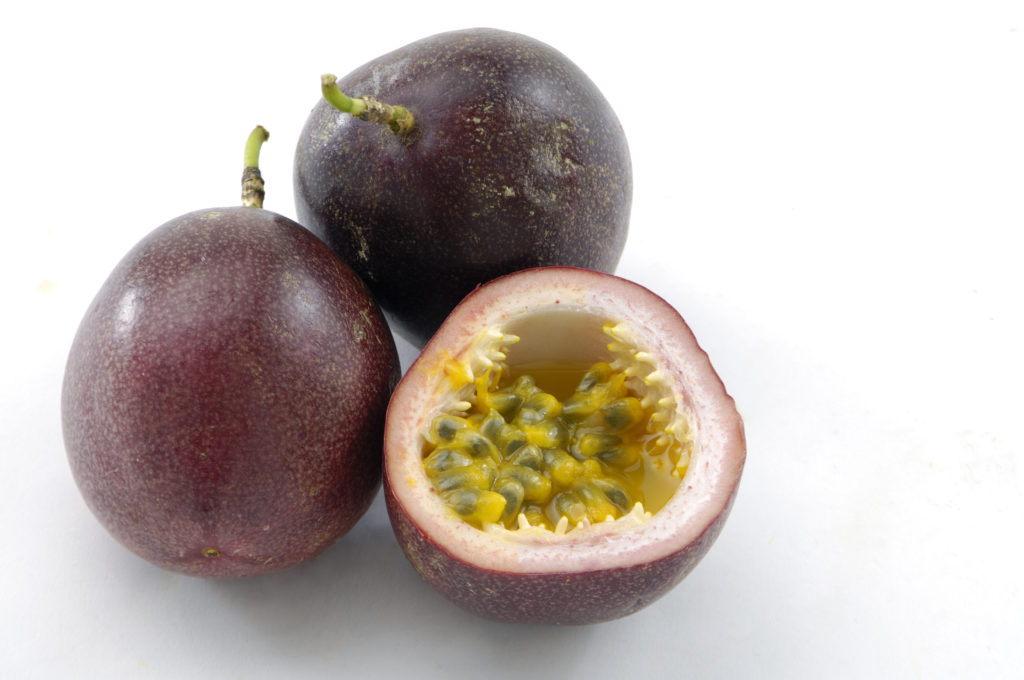
Passion fruit varieties to grow
- Purple passionfruit also called purple granadilla (Passiflora edulis): oval, purple fruit; thick-skinned; 3 to 5 inches in diameter; small seed cavity; white pulp; very sweet, fine flavor and, low acidity; large and fragrant red, green, and white flower; oval, unlobed leaves; winged stems; self-fruitful. This variety will fruit successfully in USDA Zones 10-12.
Passiflora edulis cultivars (Keep in mind cultivars are hybrids and usually do not grow true from seed; many cultivars are grafted plants from nurseries.)
- ‘Australian Purple’ also called ‘Nelly Kelly’ or ‘Nellie Kelly’: purple fruit with a mild, sweet flavor.
- ‘Black Knight’ dwarf variety perfect for container growing; tangy-sweet flavor.
- ‘Kapoho Selection’: yellow fruit; heavy bearer of large fruits; little or no pulp and juice.
- ‘Pratt Hybrid’: purple and yellow hybrid; good flavor, low in acid.
- ‘Sevcik Selection’: yellow fruit; a heavy bearer; the juice has a woody flavor.
- ‘University Round Selection’: yellow fruit; very good flavor.
- ‘University Selection No. B-74’: yellow fruit; good juice yield and very good flavor.
- ‘Waimanalo Selection’: yellow fruit; very good flavor.
- ‘Yee Selection’: yellow fruit; highly disease-resistant; fruit has a thick rind and low amount of juice; very good flavor.
- Yellow passionfruit also called Golden passionfruit, and Tropical passionfruit (Passiflora edulis f. Flavacarpa); are slightly more acidic than purple passionfruit; the fruit is large. Cultivars include ‘Panama Red’ and ‘Panama Gold’. Yellow passion fruit is the best grower in tropical regions. (Purple passion fruit can handle an occasional light frost.)
Other passion flower species that bear fruit
Here is a complete list of passion fruit species including common passion fruit (Passiflora edulis) which is listed above with its many cultivars.
- Fragrant granadilla (Passiflora alata): oval, yellow-skinned fruit 3 to 5 inches in diameter; shite pulp; aromatic, good flavor; large and fragrant red, green, and white flower; oval, unlobed leaves; self-fruitful.
- Red granadilla (Passiflora coccinea): oval, yellowish-orange skin with green stripes 2 inches in diameter; white pulp; scarlet to orange, pink, white, and purple flower; serrated leaves with no lobes; requires cross-pollination.
- Yellow passionfruit (Passiflora edulis flavicarpa): see the previous list.
- Maypop (Passiflora incarnata): oval, yellow-skinned fruit to 2 inches in diameter; tart apricot flavor; large white and purple flowers open at noon during the warm season; may require cross-pollination. This variety is a good choice for growing in USDA Zones 5-9. It will grow in northern regions where other passion vines won’t. (The name maypop comes from the popping sound berries make when they are stepped on.)
- Yellow granadilla (Passiflora laurifolia): oval, lemon yellow to orange-skinned fruit 2 to 3 inches in diameter; white pulp; pear flavor
- Sweet granadilla (Passiflora ligularis): oval, purplish-yellow skinned 2 to 4 inches in diameter; white pulp; excellent sweet flavor; greenish white flower; best in a cool climate.
- Sweet calabash (Passiflora maliformis): globe-shaped fruit to 1.5 inches in diameter; yellowish-green skin; white pulp; grape flavor; fragrant white, red, and purple flowers; long, narrow, undivided leaves; self-fruitful.
- Banana passionfruit (Passiflora mollissima): oval, yellowish-skinned fruit to 2.5 inches in diameter; white pulp; sweet-tart flavored; excellent for making juice; white, pink, and purple flowers; lobed, serrated leaves; best in cool climates.
- Giant granadilla (Passiflora quadrangularis): oblong fruit, 8 to 12 inches long; weighs up to 1 pound; yellowish-green skin with pink tint; white to pink pulp; mild flavor; best eaten like a watermelon; fragrant, reddish-purple and white flowers; unlobed leaves; may require hand pollination.
Passion fruit frequently asked questions
Q: Are passion fruit vines easy to grow?
A: Passion fruit vines are relatively easy to grow and can be productive with just one vine.
Q: Do I need two passion fruit vines to get fruit?
A: Having two vines will increase the chance of getting fruit.
Q: Where do passion fruit vines grow best?
A: Passion fruit vines are not frost-hardy, so they should be planted in a warm climate. The vines will fruit throughout the year in warm climates. Grow passion fruit vine in full sun. The vines need a trellis or some other structure to climb on.
Q: How important is water for passion fruit vines?
A: Passion fruit vines require regular watering, especially during the fruiting stage.
Q: How are passion fruit flowers pollinated?
A: Passion fruit flowers are pollinated by bees, so make sure there are some around your garden.
Q: Why do passion fruit leaves turn yellow?
A: Yellow leaves can b the result of cold weather, low humidity, or lack of magnesium or nitrogen in the soil.
Q: Why does passion fruit fail to produce fruit?
A: Lack of pollination or the over-application of nitrogen fertilizer can cause passion fruit not to produce fruit.
Q: What causes unripe passion fruit to drop?
A: Inconsistent watering, too much nitrogen in the soil, or insect pests can cause passion fruit to drop before it ripens.
Q: How long do passion fruit vines live?
A: Passion fruit plants live for about 5 to 7 years.
Also of interest:
How to Grow Feijoa Pineapple Guava
Related articles:
Planning the Home Fruit Garden
Garden Planning Books at Amazon:
- Vegetable Garden Almanac & Planner
- Kitchen Garden Grower’s Guide Vegetable Encyclopedia
- Vegetable Garden Grower’s Guide
- Tomato Grower’s Answer Book
More fruit-growing articles:
Learn how to plant, grow, prune, and harvest your favorite fruits. Click below for all you need to know.
- Apple
- Apricot
- Avocado
- Banana
- Blackberry
- Blueberry
- Cantaloupe
- Chayote
- Cherimoya
- Cherry
- Citrus
- Clementine
- Cranberry
- Currants
- Elderberry
- Feijoa
- Fig
- Gooseberry
- Grape
- Grapefruit
- Guava
- Kiwifruit
- Kumquat
- Lemon
- Lime
- Loquat
- Mandarin
- Mango
- Melon
- Mulberry
- Muskmelon
- Nectarine
- Olive
- Orange
- Papaya
- Passion Fruit
- Peach
- Pear
- Persimmon
- Pineapple
- Pineapple Guava
- Plantain
- Plum
- Pomegranate
- Pumpkin
- Quince
- Raspberry
- Strawberry
- Tangelo
- Tangerine
- Tangor
- Watermelon

